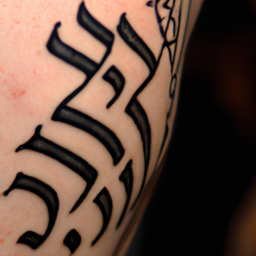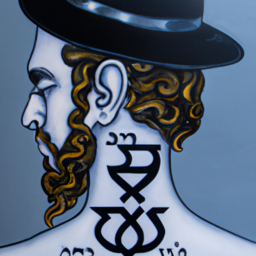“FAQs About YHWH Hebrew Tattoos: Everything You Need to Know”
Introduction to YHWH Hebrew Tattoos
In recent years, the fusion of spirituality and body art has given rise to a trend that intertwines the sacred with the personal—YHWH Hebrew tattoos. YHWH, pronounced as “Yahweh,” is the tetragrammaton, a four-letter Hebrew word יהוה that represents the most sacred name of God in the Hebrew Bible. This name is of immense significance in Hebrew culture and carries profound theological weight. As tattoos become increasingly mainstream, individuals are seeking more meaningful designs that reflect their beliefs, values, and cultural heritage. Among these, YHWH tattoos stand out as a symbol of deep religious conviction and a testament to one’s faith.
The allure of incorporating religious symbols into body art is not a new phenomenon. However, the choice to inscribe the name of God, particularly one as hallowed as YHWH, onto one’s skin is a decision laden with spiritual and cultural implications. For many, it is a permanent declaration of faith, an intimate reminder of divine presence, or a way to keep spiritual guidance close at hand. Yet, the decision to get a YHWH tattoo is not without controversy, especially within the communities that hold the name in high reverence.
The Meaning and Importance of YHWH
The tetragrammaton, YHWH, is considered the most sacred name of God in Judaism, and its significance extends far beyond its literal translation. The name is believed to be derived from the Hebrew verb “to be,” hinting at God’s eternal existence and omnipresence. The theological implications of the Tetragrammaton are profound; it encapsulates the concept of God as the ultimate being, the foundation of all existence, and the source of life. In many Jewish traditions, the name is so sacred that it is not spoken aloud, replaced instead with titles like “Adonai” (Lord) or “HaShem” (The Name).
For those who choose to get a YHWH tattoo, the act is often deeply personal. It may represent a commitment to their faith, a reminder of their spiritual journey, or a tribute to a transformative life experience. The tattoo serves as a constant reminder of the wearer’s relationship with the divine, a symbol of protection, or a source of strength during challenging times. However, it’s essential to recognize that the motivations behind such tattoos can vary widely, and each individual’s reasons are as unique as the designs they choose.
Historical Context of YHWH in Hebrew Tradition
The reverence for YHWH in Hebrew tradition is rooted in ancient scriptures, where the name first appears. It is mentioned nearly 7,000 times in the Tanakh, the Hebrew Bible, underscoring its centrality to Jewish theology. The sacred nature of the name is further emphasized by the commandment against taking God’s name in vain, which has led to a tradition of great caution and respect when referring to or writing the name of God.
Throughout Jewish history, the name YHWH has been treated with utmost sanctity. In written form, texts containing the name are handled with special care, and disposing of such texts is done through a respectful process known as “genizah.” The name’s pronunciation was traditionally known only to the High Priest, who would utter it once a year on Yom Kippur, the Day of Atonement, in the Holy of Holies of the Temple in Jerusalem.
Given this historical context, the decision to inscribe YHWH on one’s body can be seen as a departure from traditional practice. It raises questions about the continuity of reverence and the ways in which modern expressions of faith intersect with ancient customs. While some may view the tattoo as a form of homage, others within the Jewish community may perceive it as a transgression of the respect traditionally accorded to the name.
The trend of YHWH tattoos must be understood within the broader context of changing attitudes towards religious expression, identity, and the personalization of faith. As individuals seek to navigate their spiritual paths, the symbols they choose to carry on their bodies often reflect a blend of tradition and personal interpretation. The YHWH tattoo is a prime example of this phenomenon, encapsulating the tension between ancient reverence and contemporary spirituality.
In conclusion, YHWH Hebrew tattoos represent a complex interplay of faith, identity, and cultural expression. They are a testament to the enduring significance of the Tetragrammaton in Hebrew culture and the evolving ways in which individuals seek to embody their spiritual beliefs. As with any religious symbol, those considering a YHWH tattoo should approach the decision with a deep understanding of its historical and cultural context, ensuring that their expression of faith is both meaningful and respectful.

Design Considerations for YHWH Tattoos
When it comes to expressing one’s faith through body art, the design of a YHWH tattoo holds profound significance. YHWH, the Tetragrammaton, represents the most sacred name of God in the Hebrew tradition. As such, the design of a YHWH tattoo is not merely an aesthetic choice but a declaration of deep personal or religious conviction.
Traditional design elements often draw from ancient scriptures, featuring the four Hebrew letters – Yod, He, Vav, He – in their classical script. This script has a timeless quality and is instantly recognizable to those familiar with Hebrew. However, contemporary designs have emerged, incorporating modern typographic styles or integrating the Tetragrammaton with other religious symbols, such as the Star of David, the Menorah, or Christian crosses, to reflect a more personal belief system or a fusion of cultural identities.
The accuracy of the Hebrew script is paramount in YHWH tattoos. Hebrew is a language that is read from right to left, and each letter has a specific form. A slight deviation in the stroke or orientation can alter the meaning or render the text nonsensical. Therefore, it is crucial to work with a tattoo artist who is proficient in Hebrew script to ensure the tattoo is not only visually appealing but also theologically sound.
The design’s complexity can vary from the minimalist approach of the letters alone to elaborate depictions that include other religious iconography or decorative elements. Some individuals may choose to surround the letters with ornamental designs, such as flames or rays of light, to signify the divine presence. Others may opt for a more subdued representation to maintain a sense of reverence and simplicity.
Placement and Size of YHWH Tattoos
The placement and size of a YHWH tattoo are deeply personal decisions that can reflect the wearer’s relationship with their faith. Common body areas for such tattoos include the wrist, forearm, shoulder, or chest, where the tattoo can serve as a constant reminder of the wearer’s spiritual beliefs. Some may choose a discreet location, like the ankle or the back of the neck, for a more private expression of faith.
Visibility is a key consideration, as it can dictate how the wearer chooses to engage with the world regarding their religious identity. A highly visible YHWH tattoo can be a bold statement of faith, while a more concealed tattoo might be preferred by those who wish to keep their spiritual life private or who are concerned about potential social or professional repercussions.
The size of the tattoo can also carry meaning. A larger tattoo may be seen as a declaration of unwavering faith or a testament to the significance of the divine name in the wearer’s life. Conversely, a smaller tattoo might be chosen for its subtlety, reflecting a more intimate or personal connection to the divine.
Cultural Sensitivity and Respect
The decision to get a YHWH tattoo must be approached with cultural sensitivity and respect. In the Jewish tradition, the name of God is considered incredibly sacred, and its written form is treated with the utmost reverence. Moreover, Jewish law traditionally prohibits tattoos, based on interpretations of Leviticus 19:28. Therefore, non-Jews seeking a YHWH tattoo should be particularly mindful of the potential for religious and cultural insensitivity.
Understanding the religious implications of a YHWH tattoo involves recognizing the deep respect that the Jewish community has for the name of God. It is not merely a symbol or a set of characters; it represents the divine essence that is beyond human comprehension. To wear such a name on one’s body can be seen as an act of desecration or disrespect, especially if the individual does not adhere to the faith or understand its significance.
Avoiding cultural appropriation is crucial when considering a YHWH tattoo. Cultural appropriation involves taking symbols from a culture without proper understanding or respect for their original meaning and context. To prevent this, individuals should educate themselves about the history and significance of the Tetragrammaton and engage in thoughtful reflection on why they wish to incorporate this sacred name into their body art.
Ensuring respectful representation means consulting with members of the faith community, religious leaders, or scholars who can provide insight into the appropriateness of a YHWH tattoo. It also means considering the impact such a tattoo may have on one’s interactions with others, particularly those of the Jewish faith.
In conclusion, the design, placement, and cultural considerations of a YHWH tattoo are not to be taken lightly. They require a deep understanding of the symbol’s religious significance, a commitment to accuracy, and a sensitivity to the cultural and theological implications. By approaching the decision with respect and mindfulness, individuals can honor their faith and the sacred traditions associated with the divine name of YHWH.

The Process of Getting a YHWH Tattoo
Embarking on the journey to inscribe one’s skin with a YHWH tattoo is a decision that carries profound personal and spiritual significance. It is a declaration of faith, an intimate expression of one’s beliefs, and a permanent reminder of the sacred. However, the process of getting a YHWH tattoo requires careful consideration, not only to honor the religious aspect but also to ensure the quality and accuracy of the tattoo itself.
Selecting a skilled tattoo artist who is proficient in Hebrew script is paramount. Hebrew is a complex language with characters that may be unfamiliar to those not versed in Semitic languages. A slight error in the script can alter the meaning entirely, transforming a symbol of devotion into one of confusion or, worse, disrespect. Therefore, it is essential to research and choose an artist with a portfolio demonstrating their expertise in Hebrew calligraphy and a deep understanding of its nuances.
Once an artist is chosen, the pre-tattoo consultation becomes a critical step. This is the opportunity for the individual to convey the importance of the tattoo, discuss the desired design, and establish a clear understanding of the expectations. It is also the moment for the artist to provide guidance on the feasibility of the design, considering factors such as the size and placement of the tattoo. The consultation ensures that both parties are aligned in their vision, reducing the risk of miscommunication and potential disappointment.
The dialogue between the client and the artist should also cover the theological implications of the tattoo. For many, the name YHWH is considered too sacred to be depicted on the body, and this perspective must be acknowledged and respected. The artist should be sensitive to the cultural and religious weight of the symbol and work with the client to create a design that is both meaningful and appropriate.
Aftercare and Maintenance of Hebrew Tattoos
The journey of a tattoo does not end with the final ink stroke. Aftercare is a crucial aspect of ensuring that the tattoo heals properly and maintains its intended appearance. The healing process typically takes about two weeks, during which the tattooed area must be kept clean and moisturized. Following the artist’s aftercare instructions is vital to prevent infection and preserve the clarity of the Hebrew script.
Immediate aftercare involves keeping the tattoo covered with a protective film for the first few hours, followed by gentle washing with antibacterial soap and application of a recommended ointment or lotion. It is important to avoid soaking the tattoo in water or exposing it to direct sunlight during the initial healing phase. As the tattoo heals, it will scab and peel, which is a natural part of the process. Picking at the scabs can lead to ink loss and damage to the design, so it is essential to let the tattoo heal at its own pace.
Long-term care is equally important to maintain the integrity of the script. Sun exposure can fade the ink over time, so applying sunscreen to the tattooed area can help preserve its vibrancy. Regular moisturizing can also keep the skin supple and the lines of the tattoo sharp. As the body changes with age, so too can the appearance of tattoos. Touch-ups may be necessary to restore the original look of the YHWH tattoo, and these should be done by the original artist or another professional familiar with Hebrew script.
Legal and Social Considerations
The decision to get a YHWH tattoo, or any tattoo for that matter, is not only a personal and spiritual one but also a legal and social one. Laws regarding tattoos vary by region, with most places setting a legal age for obtaining a tattoo without parental consent. It is crucial to be aware of and adhere to these regulations to avoid any legal repercussions.
In addition to legal considerations, one must also contemplate the social implications of a religious tattoo. Workplace policies may restrict visible tattoos, and a YHWH tattoo could be subject to these policies depending on its placement. It is advisable to review any relevant dress codes or company policies before getting a tattoo, especially in a conspicuous area.
The social perception of religious tattoos can also vary widely. While some may view a YHWH tattoo as a beautiful expression of faith, others may see it as controversial or offensive. It is essential to be prepared for a range of reactions and to consider how the tattoo may impact interpersonal relationships and public interactions.
In conclusion, the process of getting a YHWH tattoo is one that requires thoughtful deliberation, a commitment to aftercare, and an awareness of the broader legal and social context. By approaching this deeply personal expression with respect, care, and consideration, individuals can honor their faith and carry the sacred name with them in a way that is both meaningful and responsible.

Addressing Common Questions and Dispelling Misconceptions About YHWH Tattoos
In the realm of religious symbolism and body art, YHWH tattoos hold a unique place, often surrounded by a blend of reverence and controversy. YHWH, the Tetragrammaton, represents the most sacred name of God in the Hebrew tradition. As such, it carries profound theological and cultural significance. This article aims to address frequently asked questions and debunk common myths about YHWH tattoos, providing a comprehensive understanding of their implications.
One prevalent question that arises is whether it is appropriate for individuals to get a tattoo of YHWH, given its sacredness in Jewish culture. The answer is complex and deeply rooted in religious beliefs. In Judaism, there is a strong prohibition against tattoos based on Levitical law, which states, “You shall not make gashes in your flesh for the dead, or incise any marks on yourselves: I am the Lord” (Leviticus 19:28). This has been interpreted to forbid tattoos outright, and the sacredness of the name YHWH further complicates the matter. For Jews, the name of God is so holy that it is not spoken aloud, and its written form is treated with the utmost respect. Therefore, from a traditional Jewish perspective, getting a YHWH tattoo would be seen as highly disrespectful.
However, for those outside the Jewish faith, the decision to get a YHWH tattoo may be motivated by different factors, such as a personal connection to the divine or an appreciation for the Hebrew language and its symbols. It is crucial for individuals considering a YHWH tattoo to understand the potential religious implications and to approach the subject with sensitivity and respect for the culture from which it originates.
Another misconception is that YHWH tattoos are a universally accepted expression of faith. While some may view the tattoo as a declaration of their religious beliefs, others may see it as a form of cultural appropriation or a trivialization of a sacred tradition. It is essential to recognize that the act of tattooing YHWH can be polarizing and may not be received positively by all members of the community, especially those who hold the name in high regard.
The accuracy of the Hebrew script in YHWH tattoos is another area of concern. Misinterpretations and incorrect renderings of the Tetragrammaton can lead to tattoos that are not only theologically inaccurate but also disrespectful. It is imperative for individuals to seek out skilled tattoo artists who are proficient in Hebrew script to ensure that the tattoo is a faithful representation of the sacred name.
Furthermore, there is a myth that YHWH tattoos possess mystical powers or can provide protection to the wearer. Such beliefs are not supported by Jewish theology and can be misleading. The power of YHWH in religious texts is not attributed to its written form but to the divine entity it represents. Tattoos, regardless of their symbolism, do not carry supernatural attributes.
In conclusion, YHWH tattoos are a subject that requires careful consideration and a deep understanding of the cultural and religious contexts from which they arise. Individuals must approach the decision to get a YHWH tattoo with a sense of responsibility and awareness of the potential impact on themselves and others. By addressing common questions and dispelling misconceptions, this article encourages respect for the profound significance of the symbol and promotes informed decisions regarding the incorporation of YHWH into body art. It is through such sincere and insightful perspectives that the sacredness of cultural and religious symbols can be honored in the diverse tapestry of personal expression.

